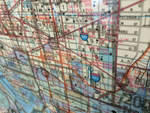Most travelers already know the warnings about packing hazardous and prohibited items—we're well informed to avoid sharp objects, flammable liquids, and firearms.
But at airport security checkpoints, plenty of innocent, nonhazardous items can appear hazardous on scanning screens and trigger a time-consuming hand search.
New scanner technology has finally enabled airport security officers to differentiate bottled water from flammable liquids, but upgrading is expensive, and airports in the United States have been slow to install the new scanning systems. For the time being, the stuff in your bag may still require a visual search by human eyes.
Don't get pulled out of line. Scan your luggage for these common culprits that may cause a security agent to double-check your stuff. You would be wise to remove these items from your carry-on while you're going through security so officers don't have to wonder if you're packing something else.
Peanut butter
The Transportation Security Administration classifies anything spreadable as a liquid. Consequently, you're only allowed to carry on less than 3.4oz/100 ml of peanut butter. We've seen TSA agents let larger amounts through, but don't bank on that. (You can of course pack as much peanut butter as you want in your checked luggage.) The same logic goes for any food used for spreading or dipping, including honey, salsa, soft cheese (even good old Southern pimento cheese), yogurt, and guacamole.
ChapStick
Dense organic matter sometimes raises flags. The TSA lists ChapStick as an approved item, but because it's a solid tube of organic ingredients, lip balm and similarly formulated cosmetics still might attract the curiosity of some inspectors. If you have one or two tubes in your bag, they'll usually be ignored, but if you're transporting multiple sticks in a cluster like a certified lip balm addict, expect to be queried.
Books
Like lip balm, a single volume usually won't cause a disturbance, but if you carry a stack of books, the mass of organic matter begins to present a problem for airport scanners. We've heard some say that the shinier the paper, the more trouble for the scanner, but we separate our books no matter the gloss—or no matter the matte.
Aluminum foil
Many metals form a shield around objects, making it impossible for scanning equipment to peer though. Even though the TSA doesn't ban aluminum foil—it even suggests using it to transport flowers—metal can make automatic bag scans more difficult, so foils may trigger a hand search. Any time you pack a metal sheet or object that could serve as a scanning barrier (cymbals are a surprisingly common issue), it's better to take that item out and send it through alone.
Cords
A few cables or wires usually won't raise eyebrows, but if you have lots of them (and with so many electronic devices to charge, tons of people do), try to separate cords into different areas of your bags. A rat's nest of wires is liable to attract scrutiny.
On the matter of recharging things, make sure that if you have a lithium battery, that it has less than 100 watt hours. If it powers more than that (101–160 Wh), the TSA might inform you that you require special permission from the airline to fly with it, and it's never allowed in your check-in luggage.
Leaded crystal glass
Airport equipment is only as good as what it can see though, and the chemical components of this type of glassware—though pretty to human eyes—can present an obstacle to sensors. Send leaded crystal through the scanner on its own. (That's probably smart to avoid breakage anyway.) You can probably leave the glass cocooned in bubble wrap as long as you tell the agent what it is.
Microphones
Security agents usually ask to inspect microphones by hand because they tend to be dense and scanning equipment sometimes has a hard time penetrating the layers. Set mics aside in a separate bin, as you would a laptop. Do the same for any specialized piece of electronics.
Salt
If you were a TSA agent and saw a bag of white powder show up in someone's luggage, what would you think? Spices, herbs, and other powdered ingredients are common souvenirs, so if you're taking any home, do yourself a favor and send your stash through separately so the agents don't have to unpack everything you own to ensure you're more of a Julia Child than a Pablo Escobar.
Obviously fake weapons
It doesn't matter if the object is clearly a toy: The TSA recommends keeping it in your checked luggage. The agency's list of prohibited carry-on items explicitly bans foam toy swords from carry-on luggage, along with water guns (even if emptied to meet liquid requirements) and forms of Nerf weaponry.
Don't ever carry bullets, regardless of whether you packed a gun to fire them. Even if the TSA misses them, authorities in your destination might not. In the Caribbean destination of Turks and Caicos, live ammunition is just as forbidden as the guns that fire it, and several Americans have spent months in jail fighting charges after they forgot to remove bullets from their bags.
Many items, like foam swords, aren't banned because they're truly dangerous, but because they could cause uncertainty—either with the scanning equipment or, potentially, with the flight crew later on.
So when you pack, it helps to think in those terms: What could cause confusion, or what might the machines have trouble scanning?
If you have questions about other stuff, from Geiger counters (fine) to glow sticks (nope—they're liquids), the TSA's official, searchable "What Can I Bring?" list is a lot more specific than it used to be, so try checking there. If you can't find the item you're curious about, snap a pic and send your question to AskTSA via Facebook Messenger or Twitter / X. You can also ask via text message by texting "Travel" to AskTSA (275-872).






